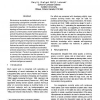Free Online Productivity Tools
i2Speak
i2Symbol
i2OCR
iTex2Img
iWeb2Print
iWeb2Shot
i2Type
iPdf2Split
iPdf2Merge
i2Bopomofo
i2Arabic
i2Style
i2Image
i2PDF
iLatex2Rtf
Sci2ools
IJCAI
1989
1989
Neuroplanners and Their Application to Eyes/Head/Neck Coordination
We review a neuroplanner architecture for use in constructing subcognitive controllers and new application that uses it. These controllers have wo important properties: (1) the ability to learn the topology of three continuous spaces: a steering space, a control space, and an observation space, and (2) the ability to integrate the three spaces so that initial and goal steering conditions can suggest a sequence of control states that lead the controlled system to the goal in the presence of obstacles. The result is a rudimentary planner or guidance system that can be used for such subcognitive tasks as robot manipulator control, head/eye coordination, and task sequencing. In this paper, we consider the second domain. The term neuroplanner is intended to convey the impression that the planner is implemented neurally and is more rudimentary than the conventional symbolic planners typical of artificial intelligence research.
| Added | 07 Nov 2010 |
| Updated | 07 Nov 2010 |
| Type | Conference |
| Year | 1989 |
| Where | IJCAI |
| Authors | Daryl H. Graf, Wilf R. LaLonde |
Comments (0)

